Yeah yeah, it’s been kind of quiet lately but I have a few projects I’ve been working on which I’ll post up here, starting with casting silicone in 3D printed molds.
I’ve been working on a new hexacopter multirotor project the last couple of weeks with a lot of fresh 3D printed parts for a camera mount and landing gear setup, but I need some kind of rubber dampers for the system. I could go shopping online to find the parts I need but funds are kind of tight at the moment so I’ve been experimenting with the tools I’ve already built to see if I can make anything useful.
I remember reading an instructable about Oogoo which is basically making a fast-cure silicone out of normal household silicone (tin curing type) and corn starch. I went back and read through that real quick and read some other things online. They say only to use Silicone I, because Silicone II doesn’t work, but they don’t say why it doesn’t work. Of course I only had GE Silicone II handy and no description of why it was no good, so I decided to try it anyways.
First I printed a mold on my OB 1.4 3D printer I built a while back. I downloaded a mold I had seen on Thingiverse for making parts similar to what I needed, so I figured it was good enough to test the process without spending time to make my own mold designs first. I used green ABS and support structures in the print, the support structures made the mold pretty rough but again good enough to test. I did sand the faces of each mold half on a flat board so they would mate fairly tight, but this isn’t a high pressure situation.
Once that was cleaned up and ready to go I started mixing up the ingredients for the Oogoo. I put some corn start and blue food coloring in a plastic container to start with, the food coloring soaked into the corn starch and immediately hardened, in the future I’d probably add it last.
I then added in the GE Silicone II to the pot, I think it was about a 2 to 1 ratio of Silicone II : Corn Starch, the lower the ratio the faster the cure time. A 5:1 ratio would cure much slower.
Then I mixed everything together using some stirring sticks. It takes just a little while to incorporate everything in the mix and I made sure to scrape the edges and bottom pretty good. I had to mix a little longer to break up the hard little clumps of dye soaked corn starch.
With the Oopsgoo mixed up I I buttered it into each mold half. I started with a small amount for each pocket and pushed the goo into the grooves first, then overfilled the rest of the pocket on each half. I pushed the halves together and let the Oogoo ooze out the sides and then clamped it with a board on either side for equal pressure.
I let the mold sit for about an hour, the stuff in the mixing container was actually setting up reasonably well, but it was still squishy. It had gotten beyond the tacky point and I could pick it up and mold it with my hands, but it wasn’t firm and rubbery like I was hoping for. After another half hour or so I popped the mold open. It looks okay for the most part for a first test run but the goo was still squishy.
I’m going to let these sit overnight and see if they stiffen up or not. I don’t mind waiting a little longer. If they don’t work out I will go hunt down some Silicone I somewhere and try again on the weekend. I’ll let you know how it goes!
Update 9/28/13
I went out and picked up some Silicone I to see how that would work out for this test mold. I used the same kind of mixture as far as corn starch and Silicone ratio but I used a red epoxy coloring dye instead of blue food coloring.
That parts turned out much better. The red Silicone I parts are much firmer, more rubbery and hold more detail than the parts I made in Silicone II. The parts made in the blue Silicone II are very soft, easy to tear and they don’t hold their shape particularly well, though they don’t have the acetic acid (vinegar) smell of the red Silicone I parts.
You can see how rubbery the Red is by the below photo. When I opened the mold the cross connection stretched out but didn’t break. In the Silicone II (blue parts) mold, these tore right away.
I wish there was a way to make these a bit stronger and more like rubber and less like soft silicone. I’m contemplating embedding things like metal washers into the mold as well to stiffen certain parts.
As for flexibility, I’ve been able to twist one of the above red Silicone I parts 360 degrees and release it and it snaps right back into shape with no tears, this could be useful for some low load motor soft coupling or something along those lines.
I twisted the Silicone II blue part and it tore in half.
This has been a good experiment and shows that the Silicone I with some printed molds will be good for some things that I need to do, and really cheap too!
Please keep in mind that while Acetic acid is used in food stuff (vinegar) it is also a byproduct of the curing of Silicone I and is stronger when you accelerate the curing so you want to do it somewhere with good ventilation to avoid any health hazards. Also Silicone I and II are tin cured silicones and should not really be considered a bio-compatible material. If you want to make things like bracelets, ear buds and other things like that you should get a platinum cure silicone or other materials, one place you can get those is Smooth-On, they have a big selection of casting products.

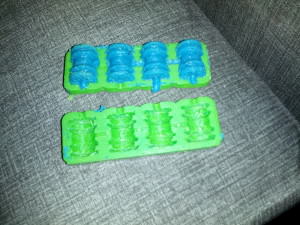
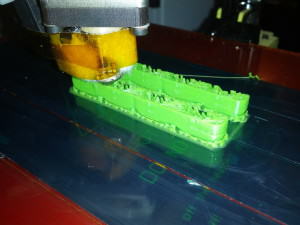
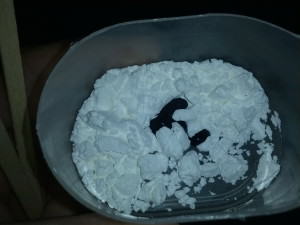
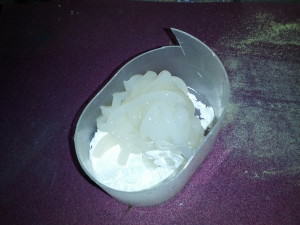
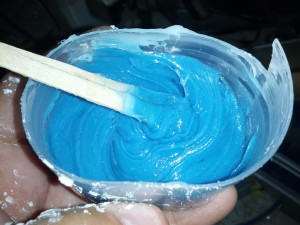
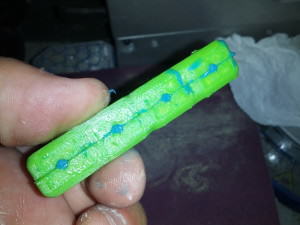
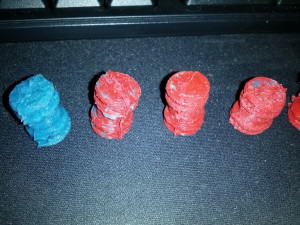
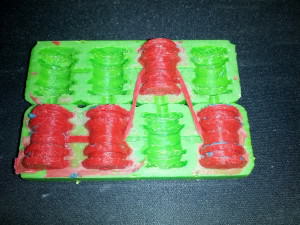
1 responses to Casting Silicone in 3D Printed Molds
You always share all your knowledge.
Leave a reply to Casting Silicone in 3D Printed Molds